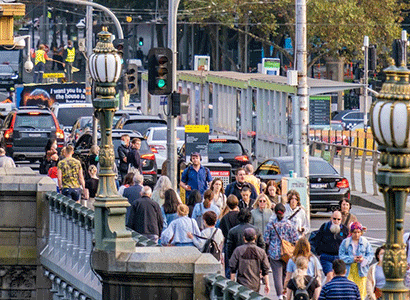 |
| Melbourne has taken over the title as Australia’s biggest city from Sydney. Photo ABC |
Australian cities are falling behind the rest of the world
(ABC) -- Australia risks “sleepwalking into a long-term loss of productivity” unless workers return to the office in greater numbers, one of the world’s foremost experts on cities has warned.
Professor Greg Clark, who has advised more than 300 cities in 40 countries, told News Breakfast that Australia and the United States are the laggards when it comes to returning to the office post-lockdowns.
Professor Clark has been tracking 150 cities since COVID began, and has found that in much of South-East Asia, India, the Middle East, Africa and Central and South America more people are working in the office now than were pre-pandemic.
“I think people are captivated that this is the new lifestyle and perhaps are not taking account of the long-term consequences of simply not being with their colleagues and not doing the things they need to do,” Professor Clark said.
“The Australian economy is en route to being a much more innovation-rich economy, but to be an innovation-rich economy, you need to be in a workplace cooperating with your colleagues.”
In Australia, Brisbane has seen a higher rate of return than Sydney and Melbourne.
The latest survey from the Victorian Chamber of Commerce found that hybrid working is still hugely popular. While the number of employees working 3-4 days a week in Melbourne CBD businesses had increased to 46 percent in March 2023, the number of employees working five days a week has fallen from 19 percent in November last year to 8 percent in March this year.
Professor Clark says while so many US workers are still working remotely because of superior technology, more mobility and less loyalty to one particular city or place, Australia’s relatively poor transport infrastructure plays a role in remote working rates here. Lack of affordable and available housing close to commerce centres in the major capitals pushes workers ever further out into the suburbs.
“Because many Australians suffer from lengthy car-based commutes due to limited public transport, the working from home idea is very appealing.
“But the risk is that what seems more efficient — working from home — is actually much less productive and ultimately leads to lower pay, job insecurity and a worse quality of life.”
Professor Clark says the solution involves building better public transport, but also developing more and better housing closer to city centres.
Australia has had falling growth in productivity over the last two decades, largely attributed to declines in business dynamism and slowing rates of innovation.
But not all experts believe that the solution is bringing workers back together in an office environment.
Dr Agustin Chevez of Swinburne University of Technology’s Centre for the New Workforce believes that rather than sleepwalking into low productivity, Australia is at risk of “sleepwalking going back to the office.”
Dr Chevez argues that intermittent isolation is critical for creative thought and innovation, and the office was an invention of a time when no other options for rapidly sharing ideas was possible, a time which has now passed.
“There is this misguided belief that good ideas happen only in groups or collaboration,” Dr Chevez said.
(Latest Update May 10, 2023)
|